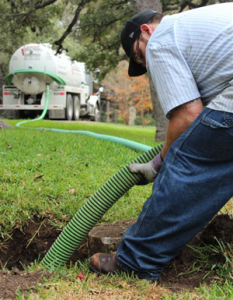For service call (210) 890-2778
or click here to request service
How Is My Septic System Cleaned?

The septic tank cleaning process can vary depending on the provider you hire. What follows is a description of the process Van Delden Wastewater Systems uses to give our customers the best septic tank cleaning possible.
Septic tank cleaning steps
Locate the septic tank
If the location of your tank is not apparent, we will locate it using a metal detector and/or metal probe. Occasionally the use of a transmitting locator may be necessary if the tank is hard to find or is under a deck, patio, room addition, etc.
Expose the septic system lid(s)
Septic tank lids are usually buried only about one foot below the surface, so they can generally be exposed with the use of a shovel (if the tank is buried three or more feet deep, an excavator may be required).
Depending on the age of your system, your tank may have one or two lids that need to be exposed. Newer homes have two compartment tanks, and both lids should be exposed so that both sides of the tank can be pumped and cleaned.
Note that your septic tank should only be pumped out through the access lids, not through its PVC cleanout.
Observe liquid levels during septic tank cleanings
During your septic tank cleaning it is important to observe the levels. Low septic tank levels may indicate a leak in the tank; high levels may indicate a problem with the drainfield.
Pump the tank
A vacuum truck sucks out the liquids and solids from the septic tank through a hose.
What happens at this point can be a big difference between pumping companies. Some companies may only pump out the liquids or whatever comes out of the tank easily. However, if the solids in the tank are thick, more work is involved in breaking down all the solids and pumping them out.
Not all septic providers will go the extra mile to ensure your tank is cleaned thoroughly — Van Delden technicians do. We use extra water to break down thick solids, and shovels can be useful in pushing those solids toward the vacuum hose. We rinse the tank with water after the solids are removed.
On rare occasions the solids are so hard that they just cannot be broken down – this is usually due to very long stretches of time between septic tank cleanings.
Cover the septic system lid back up
After the tank is pumped, we put the lid(s) back on and cover the tank back up. Then we take a minute to note the tank’s location on our work order and/or with a septic lid marker.
Provide manifest ticket
The waste that is collected from each septic tank cleaning is kept track of and reported to the treatment plant where we empty our trucks. These manifest tickets are required to be returned to the generator after the waste is dumped. Learn more about waste disposal manifests.
Clean your septic tank routinely
On average, septic tanks should be cleaned every 3 to 5 years. Do not wait until you have a problem; by then, pumping the tank will not help your system.
If you don’t know the last time you had a septic tank cleaning—or if it’s been a few years—contact us online or give us a call today to schedule an appointment!
